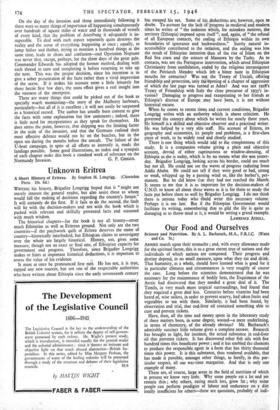Unknown Eritrea
A Short History of Eritrea. By Stephen H. Longrigg. (Clarendon Press. 10s. 6d.)
WRITING his history, Brigadier Longrigg hoped that it "might not merely interest the general reader, but also assist those to whom would fall the making of decisions regarding the country's future." It will certainly do the first. If it fails to do the second, the fault will lie with the decision-makers and not with the book which is packed with relevant and skilfully presented facts and seasoned with much wisdom.
The historical chapters—for the book is not all history—cover much Ethiopian as well as Eritrean ground. Not only are the two countries—if the patchwork quilt of Eritrea deserves the name of country—historically interlocked, but Ethiopian claims to sovereignty over the whole are largely historical. History, too, gives some measure, though not an exact or final one, of Ethiopian capacity for government and progress. Therefore, since Brigadier Longrigg makes or hints at important historical deductions, it is important to assess the value of his evidence. It must at once be pronounced first rate. He has not, it is true, tapped any new sources, but not one of the respectable authorities who have written about Ethiopia since the early seventeenth century has escaped his net. Some of his deductions are, however, open to doubt. To account for the lack of progress in medieval and modern times he writes of "the isolation which, for mistaken motives, the territory (Ethiopia) imposed upon itself "; and, again, of "the refusal of all European contacts, the sealing of Ethiopia within its own boundaries of ignorance and backwardness." Surely natural in- accessibility contributed to the isolation, and the sealing was less the result of Ethiopian intention than of the rise of Islam on the Red Sea coast and the seizure of Massawa by the Turks. As to contacts, was not the Portuguese intervention, which saved Ethiopian Christianity from annihilation, ended by the religious intransigence of the Patriarch Mendez which left a bitter taste in Ethiopian mouths for centuries? Was not the Treaty of Ucciali, offering friendship and protection, only the opening of a chapter of aggression of which the last page was turned at Adna? And was not 1928's Treaty of Friendship with Italy the close precursor of 1935's in- vasion? Damaging to progress and exasperating to her friends as Ethiopia's distrust of Europe may have been, it is not without historical excuse.
When he comes to recent times and current conditions, Brigadier Longrigg writes with an authority which is above criticism. He governed the country about which he writes for nearly three years. He himself is a skilled and objective observer and a practised writer. He was helped by a very able staff. His account of Eritrea, its geography and economics, its people and problems, is a first-class piece of work, to be widely read and closely studied. There is one thing which would add to the completeness of this study. It is a companion volume giving a plain and objective account, devoid of either captiousness or window-dressing, of Ethiopia as she is today, which is by no means what she was yester- day. Brigadier Longrigg, looking across his border, could see much but not all. He could not see the waves of progress radiating from Addis Ababa. He could not tell if they were good or bad, strong or weak, whipped up by a passing wind or, like the barber's, per- manent. But he did know that they had not reached the March. It seems to me that it is as important for the decision-makers of U.N.O. to know all about these waves as it is for them to study the facts put before them so well by Brigadier Longrigg. I do not think there is anyone today who could write this necessary volume. Perhaps it is too late. But if the Ethiopian Government would facilitate its writing, remembering that to gild the lily is quite as damaging as to throw mud at it, it would be setting a grand example.
LAWRENCE ATHILL.


























 Previous page
Previous page